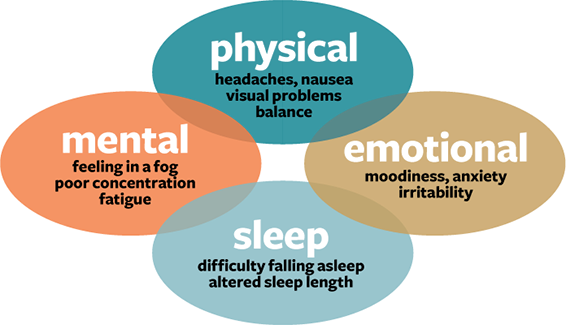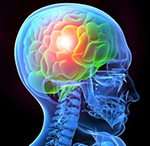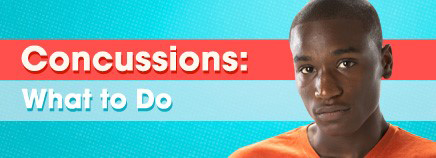Concussion Information
Browse through the links below as they apply to your unique situation to become more aware of the different symptoms to look for, what behaviors to watch for, and why rest is so important for individuals with a concussion. Remember a Concussion IS A TRAUMATIC BRAIN INJURY!
Concussion Symptoms
Possible symptoms 24 to 48 Hours after a Concussion
If you are told that your child may have suffered a concussion, it is important that you keep them from returning to play or even practice. Throughout the first two days after the concussion, you should observe your child’s behavior with vigilant eyes. The list of symptoms below was taken from “What Are the Signs and Symptoms of Concussion?” from the Centers for Disease Control and Prevention.
If any of the symptoms appear, you should take your child to the emergency room in case a more serious brain injury has surfaced and emergency treatment is necessary:
- Headache that progressively becomes worse
- Weakness, numbness or decreased coordination
- Repeated vomiting or nausea
- Slurred speech
- Drowsy appearance or cannot be awakened
- One pupil is larger than the other
- Convulsions or seizures
- Cannot recognize people or places
- Increasingly confused, restless or agitated
- Unusual behavior
- Loss of consciousness, for even a brief period of time
Possible Symptoms One Week after a Concussion
Although the first two days following a concussion are arguably the most important time to be watching your athlete’s behavior, you should continue monitoring for the entire week following a report of a possible concussion. If you notice any of the symptoms listed in the long-term symptoms section below, note the time, day and severity of the symptom, and notify your child’s athletic trainer or licensed medical provider. The information will help them determine the severity of your child’s concussion and form a care plan before the child returns to play.
Long-term Symptoms following a concussion
Concussion symptoms will last for weeks (or even months) in roughly 10 percent of cases. The following list of symptoms, from “Concussion Policy: A Guide for Schools” by Phil Hossler and Michael Collins, concentrates on the three areas most often affected by a concussion: physical changes, cognitive changes (thinking and learning) and behavioral changes. Just as with the list of symptoms possible in the first week after a concussion, note the time, date and severity of any symptoms you see and communicate them to your child’s licensed medical provider and athletic trainer.
Physical Changes
- Headaches
- Dizziness or lightheadedness
- Vomiting/nausea
- Numbness or tingling
- Loss of balance, dropping things, tripping
- Feeling worn out, exhausted, tiring easily
- Drowsiness, excessive sleeping
- Trouble falling asleep
- Sensitivity to light or noise
- Blurred vision
- Ringing in the ears
Cognitive Changes
- Confusion or feeling “in a fog”
- Confusing time and place instructions
- Having lower attention/concentration level
- Forgetfulness/difficulty with memory
- Easily frustrated with learning new material
- Taking longer to complete homework
- Difficulty organizing thoughts or words
- Misunderstanding things or instructions
Behavioral Changes
- Restlessness or irritability
- Impulsive actions
- Becoming upset or losing temper easily
- Sad or depressed mood
- Anxiousness or nervousness
Is it a concussion?
Concussions are often difficult to diagnose, since they cannot be discovered through standard methods like x-rays and CT-Scans. Because of this, concussions are often called “invisible injuries”. Following a suspected concussion, it is recommended that an athlete consult a Medical Physician (Family GP or Sport Physician) as early as possible for medical evaluation. In 90% of all sports related concussions, athletes do not lose consciousness and most sport-related concussion injuries do not require emergency care. However, it is very important that athletes with a suspected concussion remain under close observation over the first few hours, and should not be left alone or allowed to drive.
Return to Play for Athletes
Under Delaware law, a child will require medical clearance from a physician before returning to play. A Return to Play (RTP) evaluation is designed to ensure that the child is fully healed, and typically involves post-injury neurological screening, balance and vision assessments.
What happens to the brain in a Concussion?
A direct or indirect blow to the head, face or jaw can cause the brain to accelerate, and then rapidly decelerate within the skull. This acceleration/deceleration motion can cause mechanical changes to nerve fibers within the brain, and in turn, alter several important metabolic pathways. Though injury is apparent given the spectrum of symptoms experienced by a concussed athlete, no structural damage is caused to the brain itself. That is, unlike with other sports injuries (like a fractured wrist or a dislocated shoulder) nothing is visibly “wrong” or abnormal on standard imaging studies such as X-rays, computed tomography (CT) or medical resonance imaging (MRI). This “invisibility” is part of the reason why concussive injuries have historically been largely overlooked and mismanaged by the medical system. We understand now that just because we can’t see the injury, doesn’t mean an injury didn’t happen.

A concussion, in simple terms, changes the way the brain functions. In most cases, this change is temporary and reversible. Sometimes, however, changes in physical, cognitive, emotional and behavioral functions are long lasting and devastating. Researchers are only now beginning to understand the impact this injury has on the brain and the way it works.
Current research suggests that the rapid stretch of nerve fibers within the brain during a concussive trauma results in the release of various neurotransmitters (signaling molecules within the brain), which trigger the initiation of a complex neurochemical and neurometabolic pathway. Ultimately, the brain starts to consume energy more quickly than it can replenish it, creating a generalized depression in brain metabolism. These changes take place within minutes of the injury and can last for hours or days before normalization occurs. This metabolic imbalance, along with other impaired physiological processes, is thought to contribute to the physical, cognitive, behavioral and emotional signs and symptoms typically seen in a concussed individual.
Additionally, when the brain is in this state of metabolic dysfunction, it is believed to be more vulnerable to subsequent trauma. That is, a relatively minor second blow to the head may produce more severe and irreversible changes in brain function. The physiologically altered brain is essentially weakened and less able to withstand or recover from a subsequent concussion. In this way, concussive injuries are thought to be cumulative, with progressively less force required to induce trauma to the brain each time (when occurring in close temporal relation). What’s more, the symptoms experienced may be completely disproportionate to the mechanism of injury. What would have been two “mild” head injuries join in a cumulative effect to form a more severe traumatic brain injury with longer-lasting impairment.
What is a Concussion?

A concussion is a common head injury, also known as a mild Traumatic Brain Injury (mTBI). It is an injury that results from a direct or indirect blow to the head, face or jaw causing an alteration of brain function which can become evident through a variety of related symptoms.
The damage to the brain during a concussion is caused by a sudden shifting of the brain inside the skull. This shifting can cause the brain to knock against the hard bone of the skull, causing bruising to your brain and damaging brain cells.
A blow to the head can also cause a rotational injury to the brain which can cause shearing of the brain nervous fibers which can alter brain function.
What to do?

If an athlete believes they may have suffered a concussion they need to tell someone! While the athlete may think they are ok, someone else will be able to give them an unbiased opinion of their state of mind.
In order to gain accurate information and diagnosis it is important that they visit a medical provider or an individual trained in assessment and management of concussions. The medical provider will be able to tell the severity of the athlete’s injury, as well as the proper steps to follow in order to allow the athlete’s brain time to heal.
In general, a concussion requires a lot of rest to decrease the workload on the athlete’s brain. Activities such as driving, watching movies, playing video games, and any physical activity all increase brain activity and blood flow which can affect the speed of recovery. Coaches should ensure that an athlete suspected of having a concussion:
- Avoid all sports activities.
- Ensure that the athlete is evaluated by a healthcare professional experienced in dealing with concussions as soon as possible. Do not try to judge the seriousness of the injury yourself.
- Inform the athlete’s emergency contact, i.e. parents or guardians about the possible concussion.
- The injured athlete should not return to sports activities until a medical provider, experienced in evaluating concussions, confirms they are symptom-free.
What to look for?
Concussions are hard to recognize as there is no visible injury to the structure of the brain. Recognition comes from various post-concussion symptoms that may affect an individual’s cognitive & physical abilities, emotions & moods, as well as sleeping patterns.
The following is a list of possible concussion related symptoms someone may experience if they have suffered a concussion.
Common Symptoms of Concussions Include:
- Headaches
- Dizziness
- Neck pain
- Nausea or Vomiting
- Loss of balance
- Poor coordination
- Trouble focusing on objects or words
- Poor concentration
- Feeling “foggy”
- Confusion
- Amnesia, or poor memory
- Blurred or double vision
- Irritability or emotional changes
- Ringing in ears
- Slow to follow direction
- Decreased playing ability
- Easily distracted
- Vacant stare
- Drowsiness/fatigue
- Difficulty falling asleep
- Feeling “off” or not like oneself
- “Flashing lights” or seeing “stars”
What to Watch For?
First and foremost, the athlete needs rest. Rest gives the brain time to heal. This can mean missing some school and avoiding physical activities such as gym class, sports activities, exercise, weight training, recess, bike riding and wheeled activities (to name a few), until cleared by a doctor. The athlete may also need to stay away from loud, bright, crowded places and limit activities that require a lot of thinking (including school, work and driving) or visual attention (use of computers, tablets, smart phones, TV, texting and reading.
Be sure to inform anyone who may supervise or take care of the athlete after a concussion — babysitters, relatives, teachers, school officials, coaches and child care workers — so they can also ensure the athlete is following the licensed medical provider orders.
Allow the athlete to ease back into the daily routine slowly, with guidance from their doctor, one activity at a time — never all at once
It is important to remember that we can manage this injury effectively if we follow some simple steps. The most important point to remember as a parent is that you need to be in control. It is as simple as ABC:
- Assess the situation
- Be alert for signs and symptoms (listed below); and
- Contact a concussion professional who deals with concussions on a regular basis. Always ask questions and request clarifications of any points you may not completely understand.






